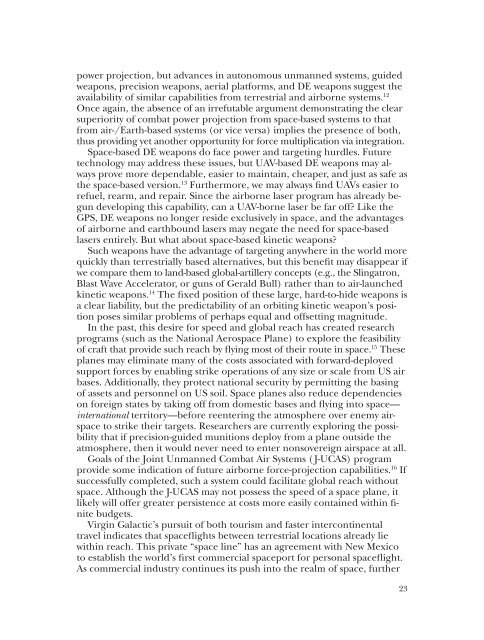Fall 2006 - Air & Space Power Chronicle - Air Force Link
Fall 2006 - Air & Space Power Chronicle - Air Force Link
Fall 2006 - Air & Space Power Chronicle - Air Force Link
You also want an ePaper? Increase the reach of your titles
YUMPU automatically turns print PDFs into web optimized ePapers that Google loves.
power projection, but advances in autonomous unmanned systems, guidedweapons, precision weapons, aerial platforms, and DE weapons suggest theavailability of similar capabilities from terrestrial and airborne systems. 12Once again, the absence of an irrefutable argument demonstrating the clearsuperiority of combat power projection from space-based systems to thatfrom air-/Earth-based systems (or vice versa) implies the presence of both,thus providing yet another opportunity for force multiplication via integration.<strong>Space</strong>-based DE weapons do face power and targeting hurdles. Futuretechnology may address these issues, but UAV-based DE weapons may alwaysprove more dependable, easier to maintain, cheaper, and just as safe asthe space-based version. 13 Furthermore, we may always find UAVs easier torefuel, rearm, and repair. Since the airborne laser program has already begundeveloping this capability, can a UAV-borne laser be far off? Like theGPS, DE weapons no longer reside exclusively in space, and the advantagesof airborne and earthbound lasers may negate the need for space-basedlasers entirely. But what about space-based kinetic weapons?Such weapons have the advantage of targeting anywhere in the world morequickly than terrestrially based alternatives, but this benefit may disappear ifwe compare them to land-based global-artillery concepts (e.g., the Slingatron,Blast Wave Accelerator, or guns of Gerald Bull) rather than to air-launchedkinetic weapons. 14 The fixed position of these large, hard-to-hide weapons isa clear liability, but the predictability of an orbiting kinetic weapon’s positionposes similar problems of perhaps equal and offsetting magnitude.In the past, this desire for speed and global reach has created researchprograms (such as the National Aerospace Plane) to explore the feasibilityof craft that provide such reach by flying most of their route in space. 15 Theseplanes may eliminate many of the costs associated with forward-deployedsupport forces by enabling strike operations of any size or scale from US airbases. Additionally, they protect national security by permitting the basingof assets and personnel on US soil. <strong>Space</strong> planes also reduce dependencieson foreign states by taking off from domestic bases and flying into space—international territory—before reentering the atmosphere over enemy airspaceto strike their targets. Researchers are currently exploring the possibilitythat if precision-guided munitions deploy from a plane outside theatmosphere, then it would never need to enter nonsovereign airspace at all.Goals of the Joint Unmanned Combat <strong>Air</strong> Systems ( J-UCAS) programprovide some indication of future airborne force-projection capabilities. 16 Ifsuccessfully completed, such a system could facilitate global reach withoutspace. Although the J-UCAS may not possess the speed of a space plane, itlikely will offer greater persistence at costs more easily contained within finitebudgets.Virgin Galactic’s pursuit of both tourism and faster intercontinentaltravel indicates that spaceflights between terrestrial locations already liewithin reach. This private “space line” has an agreement with New Mexicoto establish the world’s first commercial spaceport for personal spaceflight.As commercial industry continues its push into the realm of space, further23
















